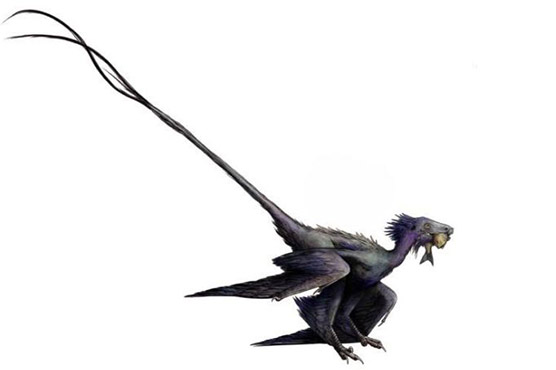'Dancing dragon' shows feathers grew differently on dinosaurs and birds

At the end of its long, bony tail - fused into a stiff rod - were two very long feathers.
WASHINGTON (Reuters) – An exquisite fossil of a fierce little Chinese dinosaur dubbed the “dancing dragon” that lived 120 million years ago - an older cousin of the Velociraptor - is showing scientists that feathers grew differently on dinosaurs than on birds.
The two-legged Cretaceous Period dinosaur, called Wulong bohaiensis, was a bantamweight meat-eater - a bit bigger than a crow - residing in a lakeside environment, researchers said. It possessed a scaly face, a mouth full of pointy teeth and one particularly dangerous toe claw, and probably hunted small mammals, lizards, birds and fish.
Wulong’s fossil, unearthed in Liaoning Province in northeastern China, includes a complete skeleton as well as soft tissues like feathers rarely preserved in such detail. Its long arms and legs each had sets of feathers that looked similar to those on bird wings, while most of the rest of its body was covered by fluffy filaments.
At the end of its long, bony tail - fused into a stiff rod - were two very long feathers.
“The specimen of Wulong is a gorgeous fossil. With the feathers and claws, I think it would have been beautiful and just a little bit scary. I’d love to see one alive,” said San Diego Natural History Museum paleontologist Ashley Poust, who led the research published this week in the Anatomical Record journal.
.jpg)
“I don’t think we know yet how it used its feathers,” Poust said. “It seems likely that they helped with temperature regulation and signaling to other animals, but what this would have looked like and how much these functions mattered remains unclear.”
Birds evolved from small feathered dinosaurs roughly 150 million years ago. But there were many feathered dinosaurs that did not fly, like Wulong. Scientists are eager to understand the plumage differences between birds and these feathered dinosaurs.
A close examination of bones showed this Wulong individual was about a year old, a juvenile still growing.
“Living birds shoot up to adult size very quickly, mainly as a way of getting strong enough to fly as soon as they can. But they may delay getting their adult feathers for a long time. Gulls, for example, don’t look like adults for three or four years even though they learn to fly in only three months,” Poust said.
The young Wulong appeared to have an adult’s plumage.
“Here is an animal that has all kinds of signals of being a juvenile, outside its bones, inside its bones, in its joints,” Poust said. “And it has long, isolated plumes extending from its already-very-long tail. This is quite different from living birds and tells us that these decorative feathers preceded adulthood in dinosaurs. Of course, perhaps they’re using these feathers in a very different way from living birds, too.”
Wulong means “dancing dragon,” so named because of its fossilized skeleton’s active-looking pose. It belongs to a group of meat-eaters called dromaeosaurs, which also includes Velociraptor. That dinosaur lived 75 million years ago in Mongolia and appears in the “Jurassic Park” films.


